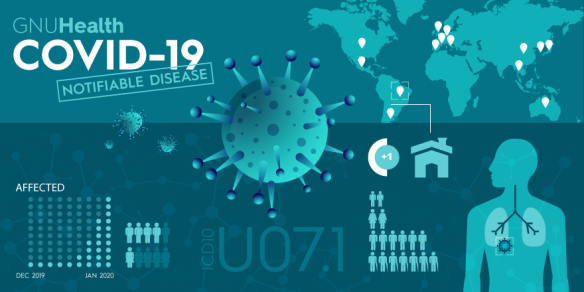
Introduction
The world is facing one of the the biggest health, economic and social crisis. A minuscule, 50-nanometer in diameter structure is putting the most powerful world economies on their knees, and hundred of thousands are tragically succumbing to COVID-19.
This article is an invitation to governments to embrace GNU Health and Libre Software for the sake of their public healthcare system in the context of the COVID-19 pandemic.
For those of you who already use GNU Health, take this article as some sort of guideline to optimize your implementation and day-by-day usage. Even though it focuses on COVID-19 disease, most topics will apply to any GNU Health implementation.
People before patients: Demographics and health infrastructure
Information is power. Good quality and timely data is crucial to tackle the COVID-19 pandemic. GNU Health has been designed on Social medicine. That is, instead of dealing directly with patients, GNU Health works first on the main pillars of a society. As a result, the government will have better tools for health promotion and disease prevention. The government will be better prepared to fight this pandemic and future outbreaks.
Domiciliary Units : DU are houses, apartments and buildings where people live. GNU Health DU model stores the infrastructure, sanitary conditions as well as the people who is living at anytime at that dwelling, in realtime. This feature is key to track possible contacts of an infected individual. Moreover, the infrastructure, surface and number of rooms provides great information in terms of possible overcrowding conditions that would facilitate the spreading of the disease. Each domiciliary unit can be georeferenced, thanks to GNU Health link OpenStreetMap.
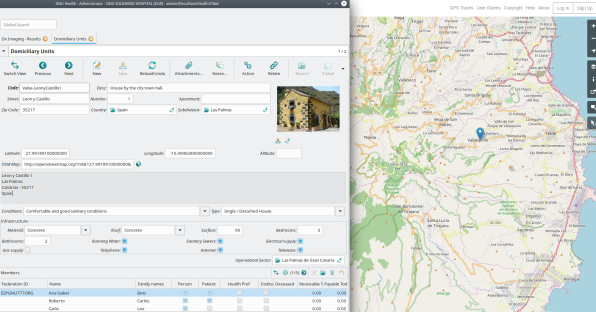
Domiciliary Unit in GNU Health: conditions, members and its geolocation linked to OSM
Operational Areas: GNU Health can divide a country in administrative areas and sectors (provinces, cities, neighborhoods,..) composed by domiciliary units and health institutions. GNU health can do real-time epidemiological reporting based on these sectors. Understanding this concept is key for COVID-19 contention or mitigation programs, since it would be able to identify early outbreaks in new areas, or focus on sections of relevant incidence. Operational areas and sectors allow us to find correlations from many indicators (ethnicity, sex, age, income, education level, population density) in the COVID-19 incidence, prevalence, susceptibility of infection or disease progression.
Health institutions: GNU Health can keep track and manage health institutions across the country. Human resources, financial and stock management, pharmacies and laboratories. In the context of the COVID-19 pandemic, you can do reporting on occupation levels of those institutions, number of beds, operating rooms, devices such as ventilators, number of health professionals and their specialties, the incidence, prevalence and mortality per institution, average time of hospitalization, and many other studies. Of course, you need to have the institutions set up.
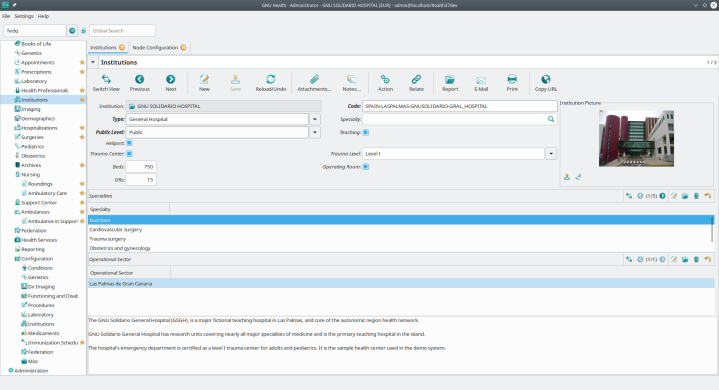
GNU Health institution model
Health professionals : In crises such the COVID-19, GNU Health allows the Ministry of health to know each health professional, their specialties, the health institution where they work and where are they located (operational sectors). Time is precious and keeping updated information of the professionals will allow rapid assignment.
Person Demographics: Age, address and domiciliary units, work and insurance. Make sure this information is stored. Age is a factor on this epidemics, as COVID-19 is particularly pernicious with the elderly population. The profession of the person is also important. For instance, health professionals are highest infected group. Demographics will also help to identify people without health coverage, unemployed, homeless and other underprivileged groups that are particularly vulnerable.
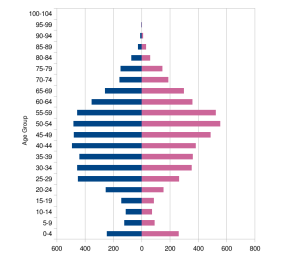
GH population pyramid sample
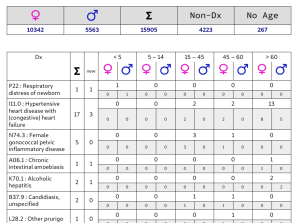
GH eval. dx report extract
Person contacts: For each person, GNU Health keeps record of their contacts and their relations (work, classmates, friends, classmates). In the scenario of a positive case for COVID-19, this information would allow to call the patient close contacts. It is key to have this information updated. Remember to fill in all possible contact mechanisms for each person (email, mobile phone, Telegram, …). Tracking and getting in touch with the person close contacts is vital.
Person Universal ID: This is one key feature of GNU Health, specially in the context of the GNU Health Federation. The person Unique ID (Federation Account) would be valid not only for the region or country, but across the world. The clinical information could be available and updated in any health institution across the country or region, immediately available for the rest.
Screening
The World Health Organization (WHO) keeps saying “test,test,test” the population. The earlier we test the population, the better we can control the spread of the disease in the community. Special population groups, such as health professionals, the elderly or those with existing health conditions should have priority.
There are rapid, point-of-care tests available in many countries that can deliver the results in less than 30 minutes. Some of them around 10 minutes. In GNU Health, you can use the SARS-CoV-2 antibodies lab test type.
GNU Health workstations can be deployed at the mobile test stations, and send the information in real-time to the Ministry of Health, with the result, signed and validated.
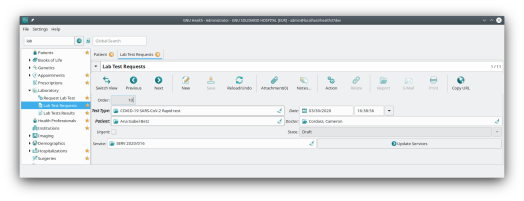

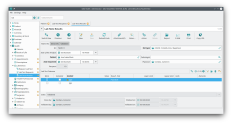
If the person has tested positive for IgM antibodies, it means she is in the early stage of the infection. IgG antibodies build up later in the infection and are part of the “immunological memory”. If IgM is positive, you must update the health conditions, include the following ICD10 code and activate the COVID-19 protocol for patient isolation and contact tracking.
The ICD10 code for COVID-19 is U07.1
U07.1 : 2019-nCoV acute respiratory disease COVID-19 : In GNU Health, the U07.1 condition (COVID-19) belongs to the infectious, respiratory and notifiable disease groups.
Indicate the lab test type and order in the related condition.
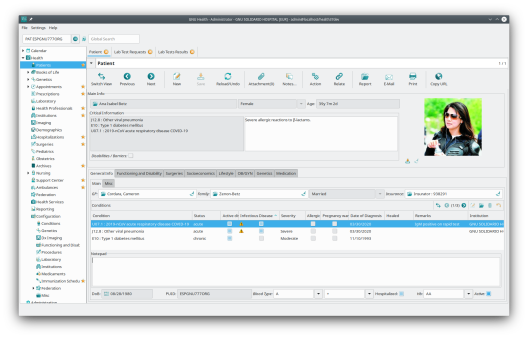
GNU Health patient screen sample, including critical information related to COVID-19 disease
Clinical Management
If the patient is tested positive but is asymptomatic or mild clinical, the patient might be sent home for home care. Please verify at that moment if the Domiciliary Unit meets the requirements (ventilation, number of rooms, number of people in the house, … ).
If the person has tested positive and/or presents signs to warrant her hospitalization, admit her to the health facility and assign her a bed in the appropriate ward. A new inpatient record will be created, with the corresponding in charge physician, treatment and nutrition plan. When admitting a patient suffering from COVID-19 is important to enter its code (U07.1 : 2019-nCoV acute respiratory disease COVID-19) as the reason of admission and discharge. This will be very valuable for statistics.
Medical History: The patient medical history is ready in GNU Health, from all the patient evaluations in the different health institutions. In the context of the COVID-19, this information is key, especially for people with chronic health conditions, such as cardiovascular disease or diabetes. The current and past medication is also stored in GNU Health, as well as surgeries.
Roundings: For each rounding, enter the vital signs, the medication provided, assess the environment and the “Six P’s” and record all the procedures done in the rounding itself. In addition, if the patient is on Intensive Care Unit (“ICU” tab), record relevant information on nervous, respiratory, cardiovascular, urinary and digestive systems, as well as any signs of infection.
The vital signs can be taken in different contexts. They can be assessed in an outpatient evaluation, inpatient nurse rounding or ICU setting.
Intensive Care Unit: If the disease progression is life threatening, the patient will be admitted to the Intensive Care Unit. GNU Health has an Intensive Care Unit module. After recording the main information of the rounding, move to the “ICU” tab for a detailed assessment of the patient in this unit. Scores such as Glasgow Coma Scale and Apache II are available. For each ICU rounding the health professional should record both the basic information as well as a detailed RoS. GNU Health allows to enter ECG information and the copy of the ECG strip per rounding, if needed.
A percentage of hospitalized patients by COVID-19 will need mechanical ventilation. GNU Health records the type and duration of the intubation, per patient on each institution. This information is very valuable for both clinical management as well as for statistics. Most countries are facing today is the shortage of mechanical ventilators. GNU Health permits to know the incidence of hospitalizations due to COVID-19, as well as the discharge rate.
Medical Imaging and Laboratory tests
Radiological findings of many COVID-19 patients are compatible with atypical pneumonia. Streaky opacities, specially at the bases are common findings. Many people with mild disease won’t show any radiological signs.
GNU Health provides different types of Dx tests. Images and observations are recorded in the system and linked to the patient history. In addition to the standard GNU health radiology package, the Intensive Care module also permits to add Xray images on each rounding to evaluate and compare the disease progression.
For large images and studies, such MRI or CT scans, we highly recommend the GNU Health Orthanc package. Orthanc is a fantastic Libre DICOM server and GNU Health can interoperate with it, thanks to the magic of the Free Software philosophy.

GNU Health radiology. Findings compatible with atypical pneumonia in a COVID-19 patient
In addition to the standard lab test types (CBC, renal and liver function …..), there are markers that can predict COVID-19 progression and severity. For instance, high ferritin levels, low platelet number and a high ESR are common in patients who develop severe disease and the cytokine storm syndrome.
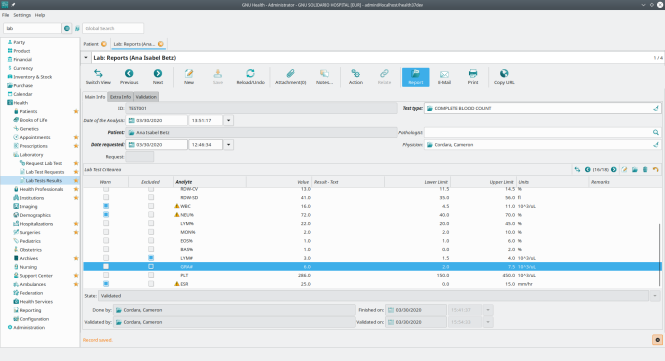
GNU Health LIMS showing a Complete Blood Count sample
All the lab test results can be exported to different formats. In the context of the GNU Health Federation a new POL (Page of Life) is created and the information can be exchanged directly in JSON format. The following pictures show the same lab test report in PDF and JSON format from the GNU Health Federation message server (“Thalamus”)
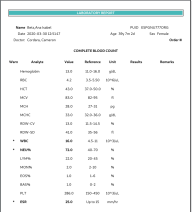
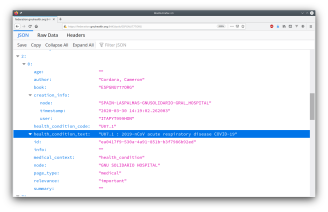
In addition to the tests done in hospitalized patients, remember that GNU Health LIMS package can be used in diagnostic and population screening, as in the case of PCR and rapid tests.
Death Certificates
The death certificate is a key document, since it has legal, administrative, demographic and epidemiological significance.
The following is an example of how we could use the GNU Health Vital Record System to generate a death certificate associated to the COVID-19 disease.
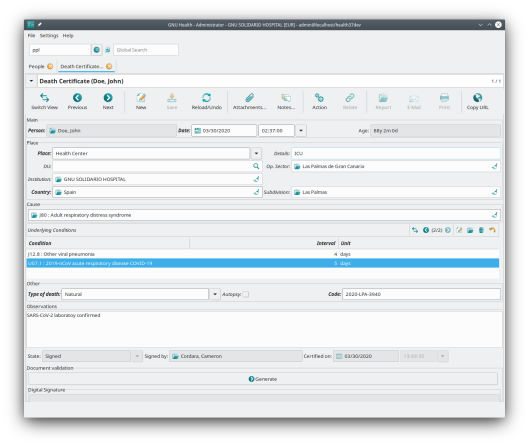
Person Death certificate related to COVID-19 disease
Digitally signing the digital certificate with the health professional and/or civil officer will make it a legal document. GNU Health uses GNUPG (GNU Privacy Guard) to digitally sign and encrypt documents.
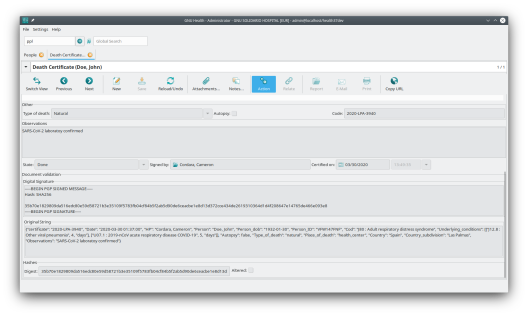
Digital signature section of the death certificate
Research
Although the respiratory system is the most affected in patients with COVID-19, other organs can be impacted. The ACE2 receptor (cell’s entry point for SARS-CoV-2) is expressed in other tissues in addition than lungs, such colon and heart. Not surprisingly, gastrointestinal symptoms and cardiac involvement, as acute myocarditis, have been reported. Recording all findings will help to improve the management of the disease of the patient, but also to share information with colleagues from the scientific community.
Sharing the patient treatments and individual outcomes will help speed up clinical trials and response to possible therapeutic agents (eg, remdesivir, lopinavir/ritonavir, hydroxychloroquine, tocilizumab…)
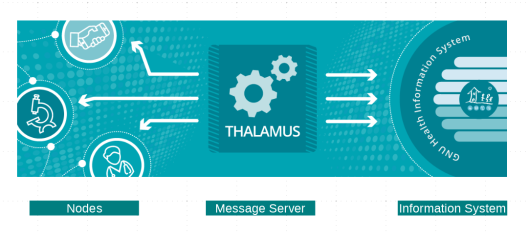
The GNU Health Federation connects thousands of nodes from health and research institutions
To be able to achieve such breakthroughs in science and in our society, we need our politicians and governments to embrace open science, open data and Libre software.
A call for Open Science, Open Data and Libre Software
The current COVID-19 pandemic is a terrible tragedy for human kind, but opens an opportunity to cooperation, to join forces and to our innate resilience.There are many gray areas and many uncertainties in the origin of the virus, disease progression and therapeutic approaches. On the other hand, the GNU Health Federation allows the scientific community to come together and tackle this beast. We can securely share huge, anonymized amount of information from all over the world to find not only the molecular basis of the COVID-19 disease, but environmental and social factors that impact on the susceptibility and disease progression.
I am returning from Japan, where I was invited to give a lecture at Kyoto university Medical Innovation Center (MIC). It was an honor to share ideas with students and professionals from a leading institution on molecular biology and biomedicine. Although I talked about GNU Health in cancer research, my presentation focused on the importance of Libre Health informatics, open science, open data in Public Health. It was surprisingly exciting the great level of engagement of the audience in these topics.
A robust, sustainable public health infrastructure must be based in cooperation. Cooperation involves open knowledge and open science. I am convinced that true evolution comes from cooperation, and not from competition. In this sense, we as members of the scientific community should share our work, whether is a computer program source code, the discovery of a protein natural variant or the development of a new therapeutic molecule.
GNU Health uses the GPL license (General Public License), which permits downloading the program, study the source code, adapt it to your center needs and share it with the community.
Keep in mind that libre software not only provides collective freedom, but is the only way to achieve privacy in healthcare. Proprietary, non-libre programs are blackboxes that jeopardize both personal privacy and public health information. In addition to that, using proprietary software in Public Health is an obscene contradiction.
To accomplish collective freedom, every single component must be Free/Libre. That is, the operating systems (both for servers and clients) as well as the applications around. We will need to share information among colleagues around the world, so the format that we use in the corresponding files should also be open.
In the meantime, stay safe. Stay home !
—
Source of this article: https://meanmicio.org/


